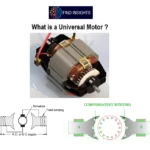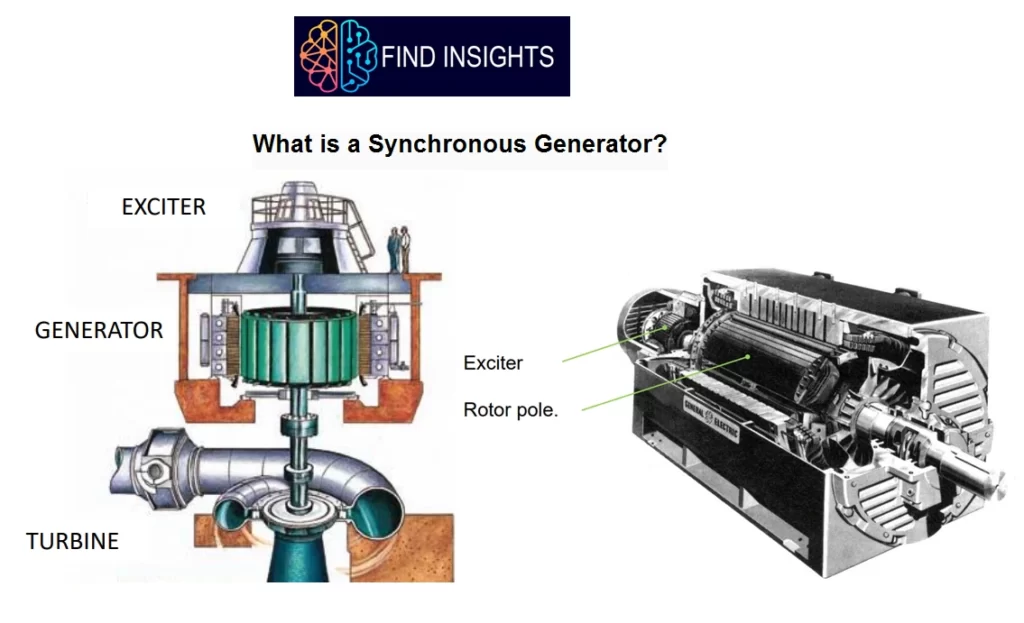
Introduction:
A Synchronous Generator is an electrical machine producing alternating emf (Electromotive force or voltage) of constant frequency.
What is a Synchronous Generator?
- Synchronous machines are principally used as alternating current (AC) generators. They supply the electric power used by all sectors of modern societies: industrial, commercial, agricultural, and domestic
- Synchronous generators usually operate together (or in parallel), forming a large power system supplying electrical energy to the loads or consumers.
- Synchronous generators are built in large units, their rating ranging from tens to hundreds of megawatts.
- Synchronous generator converts mechanical power to ac electric power. The source of mechanical power, the prime mover, may be a diesel engine, a steam turbine, a water turbine, or any similar device.
- For high-speed machines, the prime movers are usually steam turbines employing fossil or nuclear energy resources.
- Low-speed machines are often driven by hydro-turbines that employ water power for generation.
- Smaller synchronous machines are sometimes used for private generation and also as standby units, with diesel engines or gas turbines as prime movers.
Types of Synchronous Generators:

According to the arrangement of the field and armature windings, there are two types of Synchronous Generators.
- Rotating-Armature Type: The armature winding is on the rotor and the field system is on the stator.
- Rotating-Field Type: The armature winding is on the stator and the field system is on the rotor.
According to the shape of the field, synchronous machines may be classified as cylindrical-rotor (non-salient pole) machines and salient-pole machines
Construction of Synchronous Generator
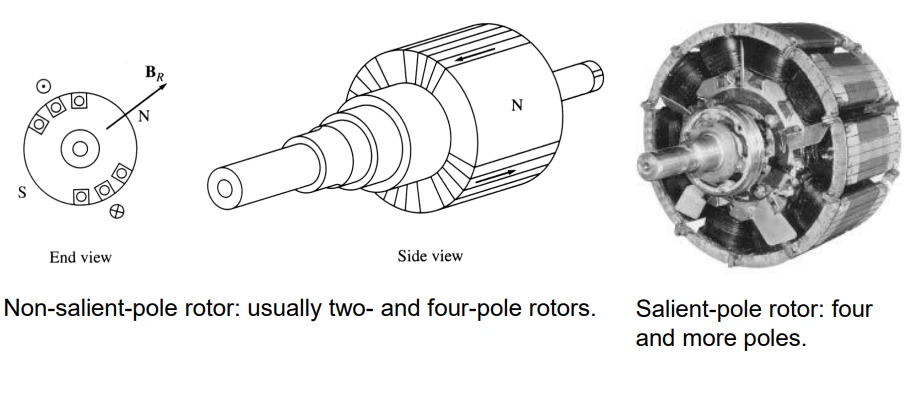
- In a synchronous generator, a DC current is applied to the rotor winding producing a rotor magnetic field. The rotor is then turned by external means producing a rotating magnetic field, which induces a 3-phase voltage within the stator winding.
- Field windings are the windings producing the main magnetic field (rotor windings
- armature windings are the windings where the main voltage is induced (stator windings)
- The rotor of a synchronous machine is a large electromagnet.
- The magnetic poles can be either salient (sticking out of rotor surface) or non salient construction.
Two common approaches are used to supply a DC current to the field circuits on the rotating rotor:
- Supply the DC power from an external DC source to the rotor by means of slip rings and brushes;
- Supply the DC power from a special DC power source mounted directly on the shaft of the machine.
- Slip rings are metal rings completely encircling the shaft of a machine but insulated from it. Graphite-like carbon brushes connected to DC terminals ride on each slip ring supplying DC voltage to field windings.
On large generators and motors, brushless exciters are used.
- A brushless exciter is a small AC generator whose field circuits are mounted on the stator and also armature circuits are mounted on the rotor shaft.
- The exciter generator’s 3-phase output is rectified to DC by a 3-phase rectifier (mounted on the shaft) and fed into the main DC field circuit.
- It is possible to adjust the field current on the main machine by controlling the small DC field current of the exciter generator (located on the stator).
Equivalent Circuit of Synchronous Generator
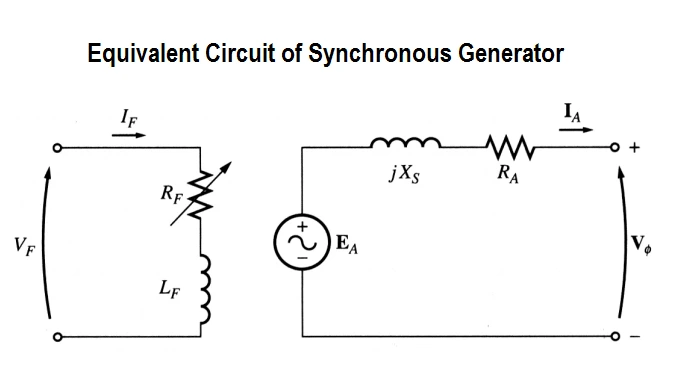
Since – for balanced loads – the three phases of a synchronous generator are identical except for phase angles, per-phase equivalent circuits are often used. Equivalent Circuit of Synchronous Generator is given below.
Formula for Synchronous Speed
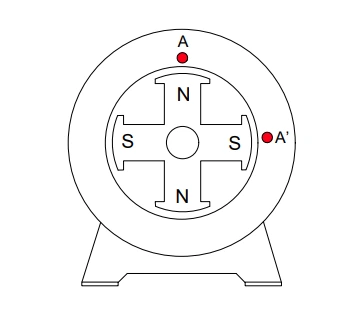
Let’s see the relation between speed & frequency to get the Formula for Synchronous Speed
Relation between Speed and Frequency
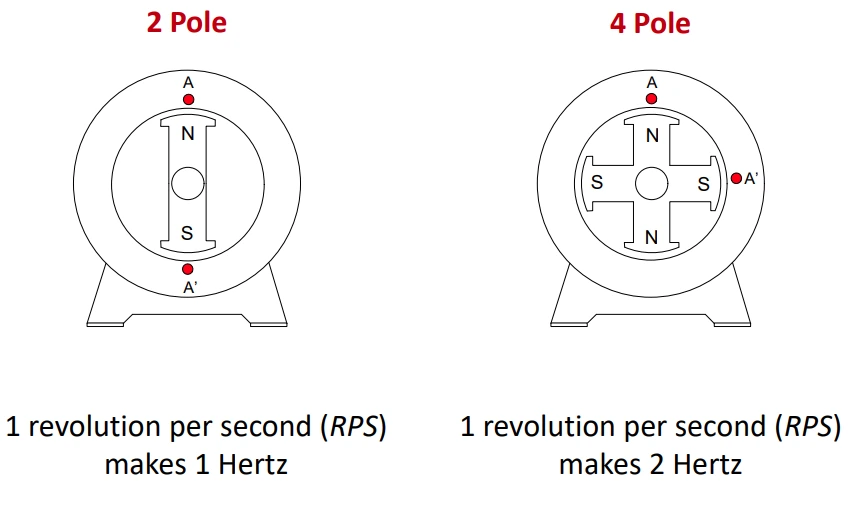
Synchronous speed is the speed at which the generator should run to produce a constant frequency
Number of cycles per revolution = P/2
Revolution per second = N/60
Cycles per second = P x N/2×60
F = P x N/2×60
Synchronous Speed, Ns = 120F/P
Where,
- F – Frequency
- P – No of Poles
- Ns- Synchronous Speed in RPM
LIKE WHAT YOU’RE READING?
CHECK OUT SOME OF OUR OTHER GREAT CONTENT HERE:
- SYNCHRONOUS MOTOR STARTING METHOD
- WHY THE SYNCHRONOUS MOTOR IS NOT SELF STARTING
- LVDT- CONSTRUCTION, WORKING PRINCIPLE , APPLICATIONS, ADVANTAGES, AND DISADVANTAGES
- HOW AN IGBT WORKS?
- SCR VI CHARACTERISTICS EXPLAINED IN DETAIL
- STEP UP TRANSFORMER: DEFINITION, CONSTRUCTION, WORKING & APPLICATIONS
- LIMITATIONS OF OHM’S LAW
- INDUCTION MOTOR: WORKING PRINCIPLE, TYPES & APPLICATION
- STRAIN GAUGE WORKING PRINCIPLE
- WHAT IS THE ZENER DIODE? – EXPLAINED
- WHAT IS OPERATING SYSTEM AND ITS TYPE
- WHAT ARE THE USES OF CAPACITOR



